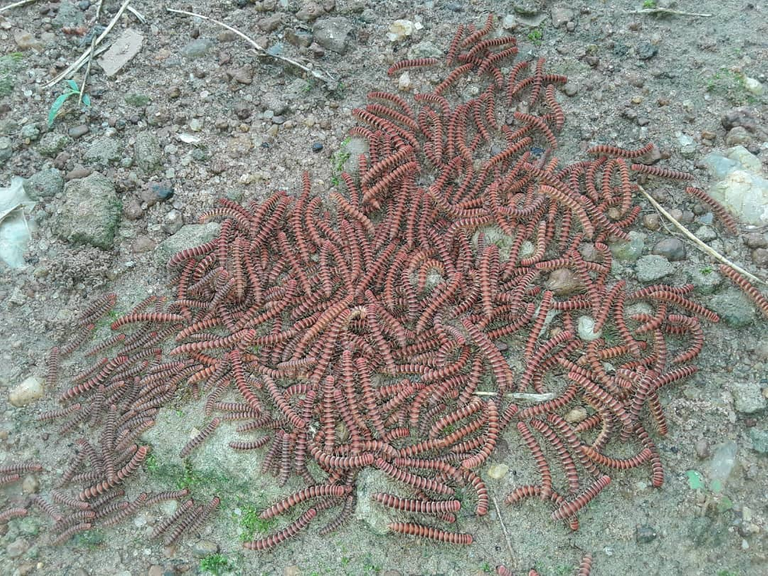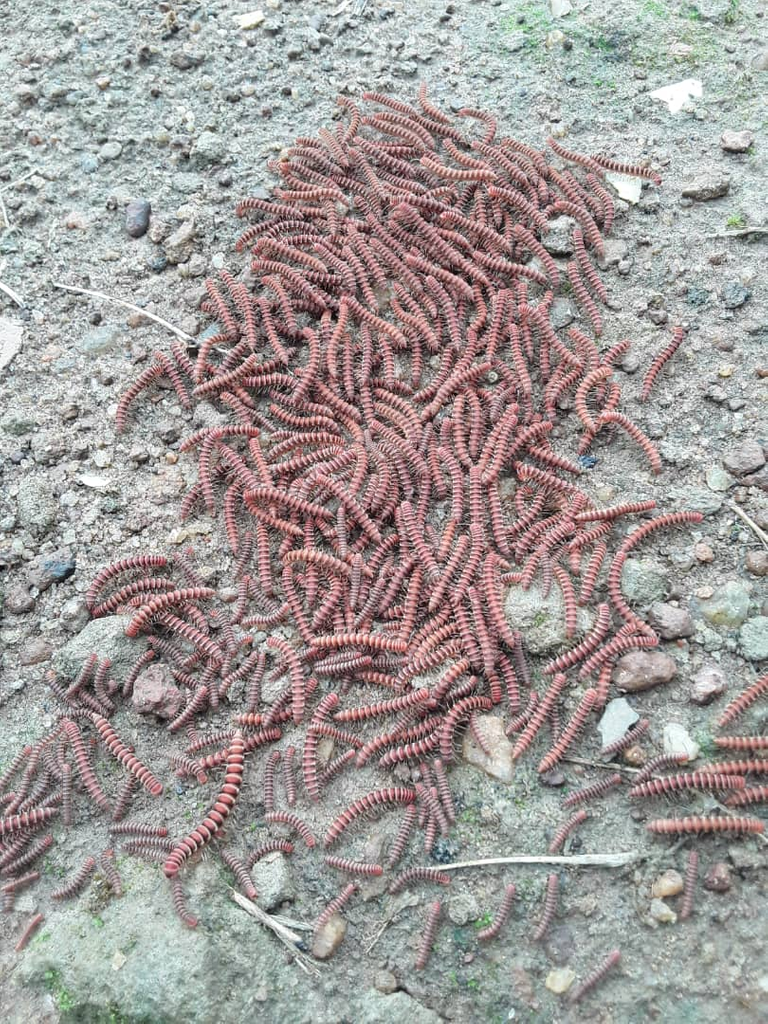The interesting world of millipede's reproduction
Millipedes, those myriad-legged arthropods that populate our forests, gardens, and damp corners, have long fascinated scientists and curious observers alike. Beyond their mesmerizing leg count and seemingly endless undulations, millipedes possess a fascinating array of reproductive strategies that shed light on the complexity of life in the animal kingdom. Inspired by the scenes I've been witnessing around my house for some weeks now, I have set out to write about the reproduction of this group of arthropods.
 The scene that inspired my writing: Young ones of millipede moving together in group. Image taken using my phone.
The scene that inspired my writing: Young ones of millipede moving together in group. Image taken using my phone.
It all starts with A Symphony of Courtship
For millipedes, reproduction is not a mere biological necessity; it's an elaborate performance. Courtship rituals are essential to their reproductive process, a mesmerizing ballet of sensory cues and delicate interactions. These rituals are crucial for identifying potential mates and ensuring compatibility and readiness for mating.
Millipedes employ a variety of sensory organs to communicate during courtship, including antennae, chemoreceptors, and specialized leg structures. Scent plays a pivotal role as millipedes release chemical cues known as pheromones to attract suitable partners. The intricate dance of chemical messaging is complemented by tactile interactions and rhythmic movements that allow potential mates to evaluate each other's suitability for reproduction.
The Dance of Shame Mating
Once the courtship phase has set the stage, millipedes progress to the intricate choreography of mating itself. The specifics of mating behaviors can vary significantly across different millipede species, highlighting the astonishing diversity within this taxonomic group. However, common themes emerge, offering a glimpse into the fascinating world of millipede reproduction.
Millipedes exhibit a range of mating positions and techniques, from the relatively simple to the exquisitely complex. Some species engage in a straightforward encounter, with the male transferring sperm to the female through specialized structures known as gonopods, located on the seventh segment of his body. In contrast, other species engage in intricate behaviors that involve intertwining their bodies, vibrating in unison, and even forming heart-shaped formations.
A Cascade of Eggs
Following the successful transfer of sperm, female millipedes embark on the crucial task of egg deposition. Unlike mammals, which bear live young, millipedes rely on eggs to perpetuate their lineage. The complexity of egg-laying strategies varies among species, reflecting the diverse ecological niches they occupy and the challenges they face.
Many millipedes employ a strategy known as oviposition, where the female lays eggs in carefully selected locations. These sites are often chosen with meticulous attention to humidity, temperature, and substrate characteristics to ensure the survival of the developing embryos. Some species fashion protective chambers for their eggs, constructing them from a combination of secretions, soil, and other materials.
Not Deadbeat Fathers
While maternal care is common in the animal kingdom, paternal care is relatively rare - extreme cases are deadbeat fathers. However, among millipedes, a few species demonstrate a form of paternal investment that challenges conventional notions of insect behavior. In these cases, the male millipede takes on the role of protector and caregiver for the eggs.
One intriguing example is the giant pill millipede (Zephronia species). After mating, the male forms a protective chamber around the eggs using a secretion that hardens into a tough shell. He remains vigilant, guarding the eggs against potential threats and ensuring optimal conditions for their development. This remarkable display of paternal care underscores the diverse strategies that millipedes have evolved to enhance the survival of their offspring.

Metamorphosis and New Beginnings
As the millipede embryos undergo development, they transform through a series of stages, resembling miniature versions of the adult form. This metamorphic journey culminates in the emergence of juvenile millipedes, each equipped with a growing number of legs as they molt and progress through their life cycle.
The transition from egg to juvenile highlights the astounding resilience and adaptability of millipedes. The young millipedes venture forth into their environment, ready to explore, forage, and ultimately contribute to the ecosystem in which they reside.
Juvenile millipedes often exhibit a range of movement behaviors, influenced by their environment, species characteristics, and ecological factors. While some species of juvenile millipedes may move individually, others can be observed moving in groups, forming clusters that serve various purposes in their survival and development.
Group movement among juvenile millipedes can have several advantages. It can enhance protection from predators, as larger numbers may deter potential attackers. Additionally, group behavior might help them navigate their environment more effectively, as they can collectively sense and respond to changes in light, humidity, and temperature. The presence of a group might also aid in locating food sources and suitable habitats.
However, it's important to note that not all species of millipedes exhibit strong group behavior during their juvenile stages. Some species might show a preference for solitary movement, while others may gather in loose aggregations. The tendency to move in groups or individually can depend on factors such as species biology, environmental conditions, and the availability of resources.
In essence, while some juvenile millipedes move in groups for various benefits, others may choose a more solitary lifestyle. This diversity in movement behavior adds to the complexity and intrigue of these fascinating arthropods' lives.
Resources consulted
- https://newatlas.com/biology/millipede-mating-landmark-imaging-study-field-museum/
- https://meadowia.com/millipede-life-cycle-reproduction/
- https://onlinelibrary.wiley.com/doi/10.1111/j.1439-0310.2010.01851.x
- https://www.uky.edu/Ag/CritterFiles/casefile/relatives/millipedes/millipede.htm
- https://www.nationalgeographic.com/animals/article/swarming-millipedes-video-senegal-spd
Congratulations @hibadurahmon! You have completed the following achievement on the Hive blockchain And have been rewarded with New badge(s)
Your next target is to reach 50 comments.
You can view your badges on your board and compare yourself to others in the Ranking
If you no longer want to receive notifications, reply to this comment with the word
STOPTo support your work, I also upvoted your post!
Check out our last posts:
I remember growing up, I always think this stuff are snakes
No. They are not. These are juvenile centipedes
Thanks for your contribution to the STEMsocial community. Feel free to join us on discord to get to know the rest of us!
Please consider delegating to the @stemsocial account (85% of the curation rewards are returned).
You may also include @stemsocial as a beneficiary of the rewards of this post to get a stronger support.